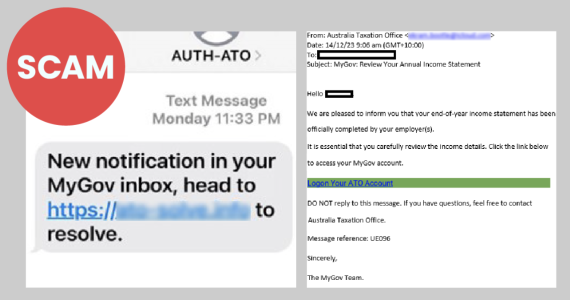ATO rings alarm over rising myGov impersonation scams
By
Seia Ibanez
- Replies 4
In an age where the threat of cybercrime often shadows digital convenience, a new wave of email and text message scams is targeting taxpayers.
The Australian Taxation Office (ATO) is sounding the alarm over fraudulent communications masquerading as official myGov correspondence, attempting to swindle individuals out of their personal information and hard-earned money.
The scam operates by sending emails or texts with enticing phrases like, ‘You are due to receive an ATO Direct refund’ or ‘You have a new message in your myGov inbox—click here to view’.
These messages are designed to mimic legitimate notifications, but they lead to fake myGov sites where scammers can harvest sign-in details and hijack accounts.
Once cybercriminals gain access to a myGov account, they can commit tax fraud by making false lodgements and rerouting payments to their bank accounts.
‘The ATO and myGov won't send you an SMS or email with a link to access online services. These should be accessed directly by typing ato.gov.au or my.gov.au into your browser,’ the ATO said.
ATO impersonation scams have seen a worrying uptick, with 1,461 reports received in February alone, marking a 1.2 per cent increase from the previous month.
This rise in fraudulent activity has prompted the ATO to implement new fraud controls, including myGovID, which requires multiple forms of identification to bolster security during the sign-in process.
Minister for Government Services Bill Shorten has recommended using the myGov app as a secure method to access government services.
‘In the same way, many of us use banking apps, most modern phones will allow you to sign in to myGov with fingerprint or face recognition, so you don’t need to use a user ID, password and an SMS code,’ Shorten said.
‘With the number of scam websites increasing dramatically, everyone needs to be vigilant. Last year, Services Australia and partners responded to over 6,000 scams attempting to impersonate myGov.’
The federal government announced an upgrade to myGov security last year, including biometric authentication, which uses your face or fingerprint as a sign-in alternative against phishing tactics.
In 2023, Australians reported losses of more than $476 million to various scams, with phishing scams being the most prevalent.

Have you or someone you know encountered a scam like this? Share your experiences in the comments below.
The Australian Taxation Office (ATO) is sounding the alarm over fraudulent communications masquerading as official myGov correspondence, attempting to swindle individuals out of their personal information and hard-earned money.
The scam operates by sending emails or texts with enticing phrases like, ‘You are due to receive an ATO Direct refund’ or ‘You have a new message in your myGov inbox—click here to view’.
These messages are designed to mimic legitimate notifications, but they lead to fake myGov sites where scammers can harvest sign-in details and hijack accounts.
Once cybercriminals gain access to a myGov account, they can commit tax fraud by making false lodgements and rerouting payments to their bank accounts.
‘The ATO and myGov won't send you an SMS or email with a link to access online services. These should be accessed directly by typing ato.gov.au or my.gov.au into your browser,’ the ATO said.
ATO impersonation scams have seen a worrying uptick, with 1,461 reports received in February alone, marking a 1.2 per cent increase from the previous month.
This rise in fraudulent activity has prompted the ATO to implement new fraud controls, including myGovID, which requires multiple forms of identification to bolster security during the sign-in process.
Minister for Government Services Bill Shorten has recommended using the myGov app as a secure method to access government services.
‘In the same way, many of us use banking apps, most modern phones will allow you to sign in to myGov with fingerprint or face recognition, so you don’t need to use a user ID, password and an SMS code,’ Shorten said.
‘With the number of scam websites increasing dramatically, everyone needs to be vigilant. Last year, Services Australia and partners responded to over 6,000 scams attempting to impersonate myGov.’
The federal government announced an upgrade to myGov security last year, including biometric authentication, which uses your face or fingerprint as a sign-in alternative against phishing tactics.
In 2023, Australians reported losses of more than $476 million to various scams, with phishing scams being the most prevalent.
Key Takeaways
- The ATO has warned about scammers sending fake emails and texts pretending to be from myGov, aiming to steal personal information.
- Scammers lure individuals with messages promising tax refunds or new messages in the myGov inbox to capture login details.
- The ATO advised that they and myGov will never send links via SMS or email to access online services, and such links should be accessed directly by typing the official web addresses into a browser.
- Australians are urged to be vigilant as scam websites proliferate and to use secure sign-in methods like the myGov app with biometric authentication where possible.








